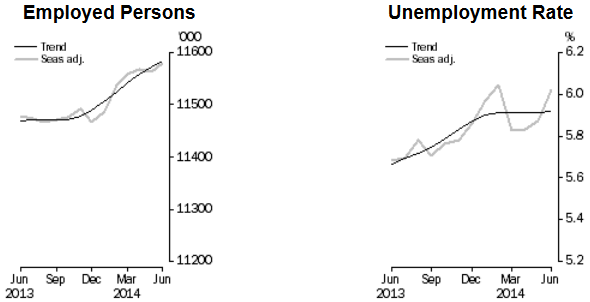I posted these to Twitter as they came out … be sure to be following @ForexLive!
Employment Change for June: +15.9K
- expected 12.0K, prior -5.1K, revised from -4.8K
Unemployment Rate June: 6.0%
- expected 5.9%, prior 5.9%, revised from 5.8%
Full Time Employment Change June, -3.8K
- prior was +22.2K
Part Time Employment Change June, +19.7K
- prior was -27.0K
Participation Rate June, 64.7%
- expected 64.6%, prior was 64.6%
Aggregate monthly hours worked increased 15.1 million hours (0.9%) to 1 ,629.1 million hours
–
- Strong employment gain, driven by part-time employment.
- Unemployment rate is higher on the month, as more people come back into the job market, the participation rate rising on the month
–
AUD/USD jumped to 0.9457 and is now much lower, under 0.9415 as i type. the market was optimisitic going into this figure and, it appears, a bit long of AUD.
From the Australian Bureau of Statistics:

–
ANZ economist Fabo:
- “We saw a strong risk of an above-market rise in employment in June reflecting some statistical payback after the fall in employment in May (which, in our view, partly reflected seasonal adjustment difficulties)
- The ‘payback’, however, was less than we expected so it was, at best, a soft outcome…
- Most forward looking indicators suggest that forthcoming jobs growth should be stronger than the 7K per month recorded in Q2
- We expect employment growth to pick up to just shy of 15K per month over the second half of the year and for the unemployment rate to remain around 6 per cent over the next year or so”
UBS:
- If unemployment continues to trend higher, & Q2 CPI was also lower than expected, it raises the risk of an unexpected RBA rate cut
- But the RBA has already said previously it expected unemployment to rise above 6%, and UBS note the recent improvement of lead indicators of the labour market – suggests that there will be enough jobs growth ahead to hold unemployment around forecast peak of 6%
Deutsche Bank’s Boyton:
- June labor force report “mixed”
- Tthe bank’s employment tracker flags only moderate growth in employment in coming months
- So expects the unemployment rate to rate drift higher
- If so, then the labor market would be a touch weaker than what the RBAhave been expecting
- Despite this says the RBA remains some distance from contemplating another easing in monetary policy
Westpac:
- Hours worked rose 0.9% in Jun following on from a 2.1% rise in May (revised up from an original estimate of 1.7%)
- All up hours worked have risen 2.1% in the year to Jun. Firms may be nervous about employing more staff but they are working their existing staff harder.
- So if you look you can find something in the June Labour Force Survey to fit any current view on the Australian economy. As such, you can argue that the labour market is, at best or worst, holding ground rather than finding a stronger or weaker trend.
- In the year to Jun, total employment has lifted 100.3k or 0.9%. While this is broadly consistent with the other labour market indicators we use (various business surveys and consumer sentiment) it has not been enough to match population growth and as such, the employment to population ratio has fallen to 60.8% from 61.4% a year earlier.
- The only reason the unemployment rate has not lifted more (from 5.7% to 6.0%) is that the participation rate has declined from 65.1% to 64.7%. If the participation rate had held at around 65%, the unemployment rate would now be around 6½%.
- The forward looking indicators continue to point to an on ongoing sound if rather lacklustre labour market. As such, within the month to month volatility of the survey an average again of around 10k to 15k per month is still the most likely outcome over the next few months. This will not, however, be enough to prevent the unemployment rate from rising further without an ongoing decline in participation.



